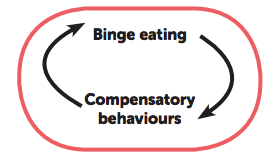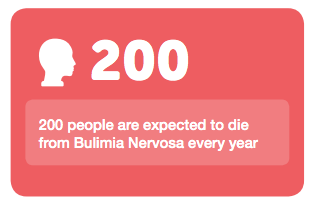What is Bulimia Nervosa?
This fact sheet describes the symptoms, causes, function and treatment options for Bulimia Nervosa.
What is Bulimia Nervosa?
Bulimia Nervosa is a type of eating disorder characterised by episodes of binge eating followed by compensatory behaviours, which are intended to prevent weight gain.
The term binge is commonly misused to describe mild over-eating, or even normal eating. In reality, during a binge episode a person will eat an unusually large amount of food in a short period of time.
People with Bulimia Nervosa experience a sense of loss of control during a binge episode and then engage in compensatory behaviours as a result of intense feelings of guilt and shame.
Compensatory behaviours are intended to prevent weight gain after binge eating. They include self-inducing vomiting, dieting, fasting, excessive exercise and the misuse of laxatives, diuretics or other medications and drugs.

Anyone experiencing this pattern of eating should seek treatment as it can be resolved.
Bulimia Nervosa is a serious mental illness that can cause a range of physical complications, some of which can be life threatening. People who experience Bulimia Nervosa typically maintain an average weight, which makes the disorder difficult to detect. Furthermore, their behaviours are usually kept secret due to extreme levels of guilt and shame, which hinder the individual seeking treatment.
The Function of Bulimia Nervosa
Bulimia Nervosa is often used as a way of dealing with underlying personal, emotional and psychological difficulties. It can be experienced by the individual as helping them to function by numbing their emotions, providing a distraction or a sense of accomplishment, and thereby helping them feel in control.
“For me, bingeing and purging was a way of dealing with anxiety and stress. I kept telling myself that I was in control and that this was the last binge. But in reality, I was totally trapped.” - James, 28
The Causes of Bulimia Nervosa
The exact causes of Bulimia Nervosa are not known. A range of factors can play a role in the development of the disease, including genetics, environment and societal influences as well as pre-existing anxiety or depression.
Bulimia Nervosa generally develops in the late teens and is experienced by men as well as women. People with Bulimia Nervosa place extreme importance on their body shape and weight in determining their self-worth.
Bulimia Nervosa is a treatable illness and there is a lot of evidence about the treatments that work. The sooner someone gets help, the better.

Signs & Symptoms of Bulimia Nervosa
Physical signs
- Frequent changes in weight, loss or gains
- Signs of damage due to vomiting, including swelling around the cheeks or jaw, calluses on knuckles, damage to teeth and bad breath
- Feeling bloated, constipated
- Disturbance of menstrual periods in women
- Fainting or dizziness
- Feeling tired and not sleeping well
Psychological signs
- Preoccupation with eating, food, body shape and weight
- Sensitivity to comments relating to food, weight, body shape or exercise
- Low self-esteem and feelings of self-loathing, shame or guilt, particularly after eating
- Distorted body image
- Obsession with food and need for control
- Depression, anxiety or irritability
- Body dissatisfaction
Behavioural signs
- Evidence of eating large amounts of food
- Vomiting or using laxatives, enemas, appetite suppressants or diuretics
- Eating in private and avoiding meals with other people
- Anti-social behaviour, spending more and more time alone
- Repetitive or obsessive behaviours relating to body shape and weight
- Secretive behaviour around food
- Dieting behaviour
- Erratic behaviour
- Self-harm, substance abuse or suicide attempts
Treatment Options
Research suggests that a range of psychological therapies such as Cognitive Behaviour Therapy (CBT), Dialectical Behaviour Therapy (DBT) and Interpersonal Therapy (IPT) are most effective. Ongoing medical monitoring by a GP and nutrition support with a Dietitian is also important.
For adults, CBT has been shown to be the most effective for treatment of Bulimia Nervosa. ‘Guided self-help’ has also been shown to be effective.
For children and adolescents, both Family Based Treatment (FBT) and CBT have research to support their use with Bulimia Nervosa.
Hospital-based treatment may be required if the symptoms are very severe or if there are any medical complications that need immediate treatment.
A trained and skilled community clinician will almost always be needed to deliver evidence-based treatment.
For anyone with Bulimia Nervosa, it is important to seek care from an empathetic and skilled GP who can remain involved in your care throughout treatment.